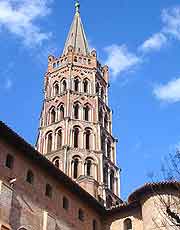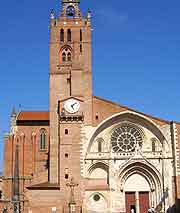Toulouse History Facts and Timeline
(Toulouse, Haute-Garonne, Midi-Pyrenees, France)

Known as the 'Ville Rose', Toulouse has a fascinating history that dates back some 2,000 years, when a small band of Celts settled in the Garonne Valley. In the 2nd century AD, the Romans established a colony here. The settlement must have prospered, because a hundred years later, Toulouse had acquired its own defensive walls.
From the 5th century AD, Toulouse fell victim to a succession of Barbarian attacks. The most successful were led by the Visigoths, although later the Franks also managed to take control of the settlement. By the 9th century AD, the settlement was probably about the size of a county town.
Early History
During the early Middle Ages, the town rose in status, becoming the capital of the County of Toulouse. Governed by Raimond II and a group of city nobles, its urban boundaries stretched beyond its walls to the north and as far south as Saint Michel.
In the 12th century, consuls took over the running of the town and these proved to be difficult years. In particular, it was a time of religious turmoil. In Toulouse, the Cathars tried to set up a community here, but were routed by Simon de Montfort's troops. The subsequent arrival of the Inquisition led to a period of religious fervour during which time the Dominican Couvent des Jacobins was founded. In 1229, a theological university was also set up. Then, in 1271, Toulouse was made a royal city. With this accolade, it started to transform itself into an intellectual and artistic centre.
Arrival of the Plague, War and Famine
The 14th century was to mark a real downturn in the city's fortunes. First came outbreaks of plague, then the Hundred Years' War. Famine and floods also took their toll on the city. It wasn't until the 15th century that Toulouse started to enjoy a 'golden age'. A Parliament was set up here by Charles VII and the city's merchants grew ever wealthier. Their economic well-being was mostly based on a plant-based blue dye known as pastel, which they exported throughout Europe. These pastel merchants built grand town houses and, before long, both architecture and the fine arts flourished in the city as never before.
The bubble finally burst in the mid-16th century. Another blue dye arrived from America, known as indigo. It wiped out the pastel trade in one fell swoop. Religious conflict broke out between the Catholics and the Calvinists. As if that wasn't enough, many buildings were destroyed by fire and there were yet more outbreaks of famine and plague.

From Enlightenment to the Present Day
In 1761, a Toulouse merchant, Jean Calas, was accused of murdering his own son to prevent his conversion to Catholicism. Calas was put to death a year later. Toulouse's persecution of Protestants such as Calas was widely condemned and religious intolerance did gradually disappear.
During the remainder of the 18th century, the city was slowly modernised. This included a period of urban rebuilding, which began in earnest from 1750. New projects included the building of the Jardin Royal. The Grand Rond also dates to this period, along with the Canal de Brienne and the Quai Dillon.
In 1856, the Matabiau Station was opened, launching a new age in transportation. Other transport improvements included the widening of streets to form more spacious boulevards. Gradually, Toulouse emerged as a modern French city.
During the early decades of 20th-century history, Toulouse witnessed the mass arrival of immigrants from northern France,
Italy and
Spain. New industries arrived in the city, including aircraft manufacturing and chemical factories. The French airmail service was set up here too, while in World War Two, Toulouse played a vital role in the Resistance movement.
In the 1960s, a new wave of immigrants arrived in the city, this time from
Algeria. New homes were built and the city's boundaries were extended yet further. Toulouse's industry interests have more recently reached out to include space exploration and electronics, and today, this is France's fourth-largest city.
 Known as the 'Ville Rose', Toulouse has a fascinating history that dates back some 2,000 years, when a small band of Celts settled in the Garonne Valley. In the 2nd century AD, the Romans established a colony here. The settlement must have prospered, because a hundred years later, Toulouse had acquired its own defensive walls.
Known as the 'Ville Rose', Toulouse has a fascinating history that dates back some 2,000 years, when a small band of Celts settled in the Garonne Valley. In the 2nd century AD, the Romans established a colony here. The settlement must have prospered, because a hundred years later, Toulouse had acquired its own defensive walls.